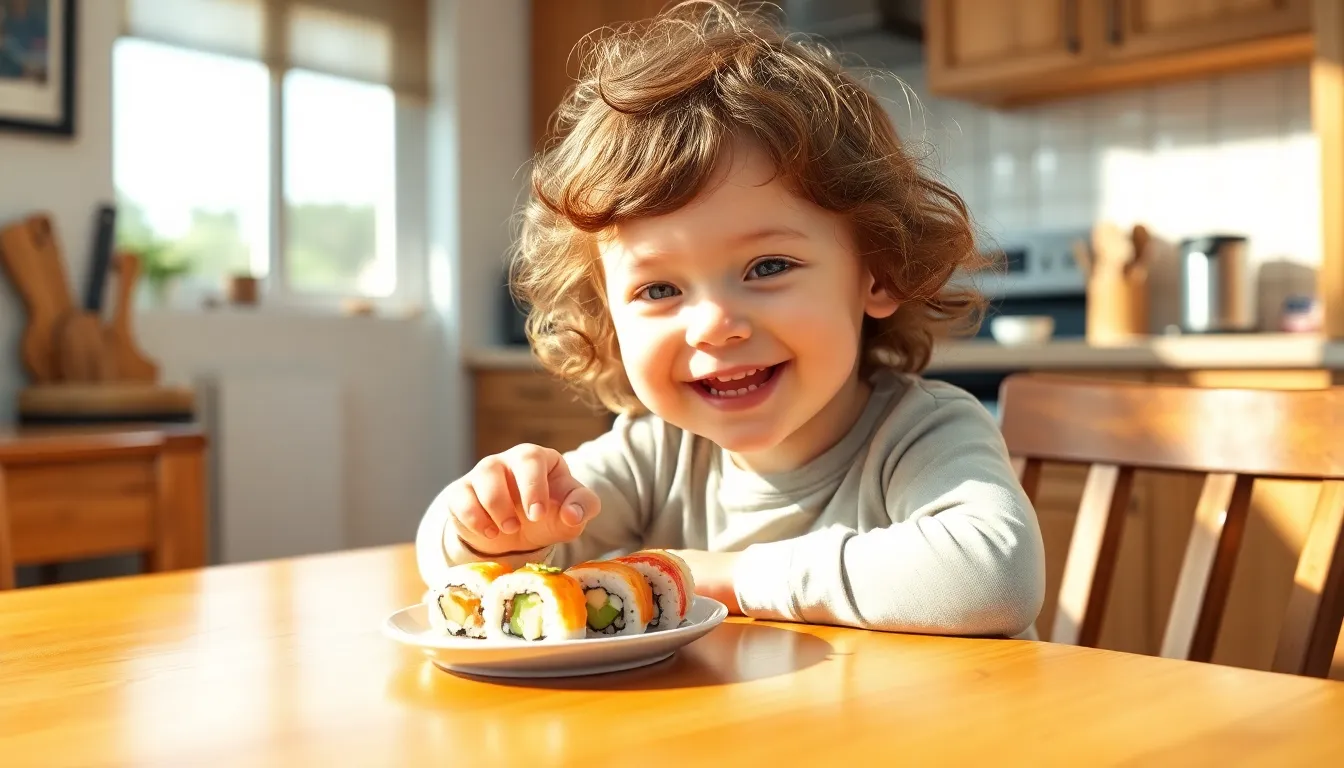Sushi: a delightful blend of flavors and textures that tantalizes taste buds of all ages. But when it comes to toddlers, the big question arises—can they dive into this culinary adventure? While sushi rolls may seem like an exotic treat, parents often wonder if their little ones are ready to embrace the seaweed and raw fish combo without turning mealtime into a dramatic episode of “Survivor: Kitchen Edition.”
Table of Contents
ToggleCan Toddlers Eat Sushi: An Overview
Sushi can present both appealing flavors and nutritional benefits for toddlers. Safety concerns often arise due to ingredients like raw fish and potential allergens. Parents might worry about the risks of foodborne illnesses associated with raw seafood.
Certain types of sushi, such as those made with cooked fish or vegetables, offer a suitable option for young children. Cooked varieties reduce health risks while minimizing exposure to bacteria. Additionally, sushi rolls featuring ingredients like cucumber, avocado, or crab can provide essential nutrients.
Parents must consider ingredients carefully. Toddlers may encounter seaweed, which offers fiber and vitamins but can pose choking hazards. It’s essential to cut sushi into manageable sizes.
Monitoring for allergic reactions is crucial since ingredients such as shellfish or sesame may cause negative responses in some children. Serving sushi in moderation helps balance exposure while allowing toddlers to enjoy diverse tastes.
Consulting with a pediatrician can guide parents on when and how to introduce sushi. Age, dietary preferences, and individual health conditions also play a role in this decision. Knowing the child’s eating habits allows parents to make informed choices about what’s suitable.
Parents should choose reputable restaurants or prepare sushi at home for better control over ingredients. Home preparation also ensures appropriate cooking methods and sanitary conditions. Being cautious enables families to safely explore the world of sushi together.
Nutritional Benefits of Sushi

Sushi offers appealing flavors along with significant nutritional advantages for toddlers. Various ingredients contribute to a well-rounded diet, making sushi an intriguing choice for parents.
Essential Nutrients in Sushi
Sushi contains essential nutrients beneficial for toddlers’ growth and development. Fish provides high-quality protein, vital for building muscles and tissues. Omega-3 fatty acids found in fish support brain health and cognitive function. Seaweed supplies dietary fiber and important vitamins like A, C, and E. Including vegetables such as cucumber and avocado adds vitamins, minerals, and healthy fats, ensuring a balanced meal.
Sushi Ingredients Suitable for Toddlers
Certain sushi ingredients cater specifically to toddlers’ dietary needs. Cooked fish like crab or shrimp offers a safe alternative, reducing the risk of foodborne illnesses. Vegetables, including cucumber, avocado, and carrots, enhance nutritional value while being easy to chew. Sushi rolls made with sushi rice and vegetables present manageable flavors and textures. Parents can explore various options while keeping safety a priority, ensuring a positive introduction to sushi for young children.
Safety Considerations
When considering sushi for toddlers, understanding safety is essential. Ingredients can pose health risks, particularly raw fish.
Risks of Raw Fish for Toddlers
Raw fish carries the risk of foodborne illnesses, which toddlers are more susceptible to due to underdeveloped immune systems. Bacteria and parasites found in undercooked seafood can jeopardize a child’s health. Symptoms vary and may include nausea, vomiting, or diarrhea. Furthermore, certain types of raw fish, like tuna or mackerel, may contain higher levels of mercury, posing additional concerns for young children. Exposure to mercury can affect cognitive development. Careful consideration of raw fish types and sources is crucial to safeguarding toddler health.
Alternative Sushi Options
Opting for alternative sushi choices can make sushi safer for toddlers. Cooked seafood, like crab or shrimp, presents a lower risk and maintains flavor and nutrition. Vegetable rolls packed with ingredients like cucumber, avocado, or carrots deliver essential vitamins without health concerns. Sushi made with cooked fish reduces exposure to harmful bacteria while providing protein and omega-3 fatty acids. Taking the additional step of cutting sushi into smaller pieces minimizes choking hazards. Making sushi at home or choosing reputable restaurants ensures better control over ingredient quality and preparation methods, creating a more enjoyable dining experience for toddlers.
Tips for Introducing Sushi to Toddlers
Parents can introduce sushi to toddlers by focusing on safety and taste. Starting with cooked sushi offers a safer option. Cooked sushi rolls, such as those containing shrimp, crab, or tempura vegetables, minimize health risks associated with raw fish. Opting for these choices ensures toddlers enjoy flavor while avoiding potential foodborne illnesses. Parents should consider cutting sushi into small, bite-sized pieces to make it more manageable for little ones.
Starting with Cooked Sushi
Cooked sushi represents an excellent starting point for young children. Utilizing ingredients such as shrimp tempura or cooked crab provides flavor and essential nutrients without health concerns. Many toddlers enjoy the crunchy texture and mild taste of tempura vegetables. Furthermore, parents can enhance the experience by allowing toddlers to help choose ingredients. Engaging children in the process often encourages them to taste new foods.
Engaging Toddler-Friendly Sushi Ideas
Creating toddler-friendly sushi involves selecting appealing ingredients. Using avocado, cucumber, or adorable shapes can make sushi more enticing. Vegetable rolls can serve as a vibrant, colorful option. Incorporating fun dipping sauces like soy sauce or mild salsa can also increase their interest. For added fun, parents can involve toddlers in the preparation, encouraging them to roll sushi or arrange veggies. Establishing a positive, interactive experience fosters curiosity toward trying new foods.
Introducing sushi to toddlers can be a delightful experience when done thoughtfully. By selecting safe ingredients and focusing on cooked or vegetable options, parents can provide a nutritious and enjoyable meal.
It’s essential to consider the child’s individual needs and preferences while also monitoring for any potential allergies. Making sushi engaging by involving toddlers in the preparation process can spark their interest in trying new flavors.
With careful planning and attention to safety, sushi can become a fun and healthy addition to a toddler’s diet.





